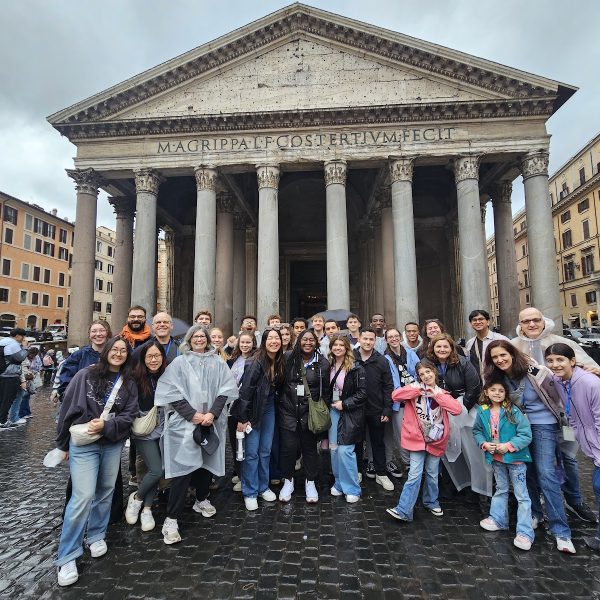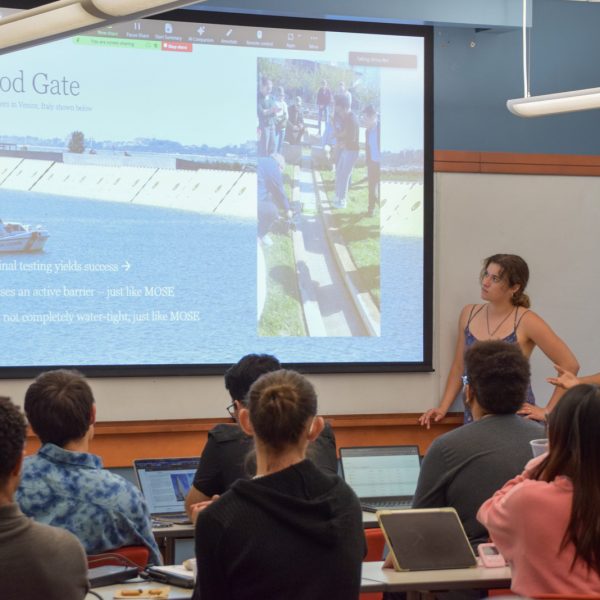by Lucas Johnson
More than 20 Vanderbilt engineering students recently visited Italy during their spring break to not only see some iconic structures, but also learn the engineering behind the Pantheon and Venice’s sophisticated floodgates so they could apply that knowledge to future engineering projects of their own.

The trip was part of an inaugural class taught this semester in the Civil and Environmental Engineering Department and sought to give the 22 students a deeper understanding of the engineering behind some of Italy’s structures, such as the ancient Pantheon and MOSE project designed to protect the city of Venice from flooding. The MOSE project is an integrated system consisting of rows of mobile gates that uses air pressure to keep water levels in check.
As part of their class assignments, the students worked in groups to design floodgates as well as build and test concrete dome prototypes based on their studies of how the Pantheon was constructed. The class was originally scheduled for 15 students, but instructors increased the number because of interest.
“We wanted to help students understand the history and the beauty of structural engineering with the hope that they will be able to better work with architects to achieve beautiful and structurally sound buildings in their careers,” said Lori Troxel, professor of the practice of civil and environmental engineering and a class instructor.
While in Italy, the students traveled to Rome, Venice, and Milan. In Milan, they spent time with architects who had worked with the renowned architect Zaha Hadid, and met with a group of students from Polytechnic University of Milan who were taking a class on structural health monitoring. In Venice, they talked to engineers involved with the city’s unique flood gates. And in Rome, the students visited ancient sites like the Pantheon, the Coliseum, and the Roman Forum.
Winnie Huang, a junior majoring in civil engineering, marveled at the construction of the Pantheon.
“Seeing the Pantheon in person made clear why its design has allowed for it to last thousands of years,” said Huang. “Despite the cracking as a result of the hoop stresses of the dome, the Pantheon has notably stayed structurally sound due to its construction with Roman concrete, which contains self-healing properties. Although we didn’t personally have the opportunity to work with Roman concrete for our project, we took inspiration from the Pantheon in designing our own miniature concrete dome.”

For Santino Clemente, whose grandparents are Italian immigrants, the trip was his third time in Italy and one he had looked forward to because after each visit he found himself wanting to go back. Before the latest trip, he watched a documentary about the MOSE project.
“Being there in person and getting to ask all our questions to the engineers was an awesome experience,” said Clemente, a junior majoring in mechanical engineering.
After returning from Italy, the students tested floodgates they had constructed in a creek at a park near the university. In constructing the floodgates, they had a budget of $50 and could use whatever scrap materials they found.
Philmon Gashaw, also a junior mechanical engineering major, said his group used a magnet, wood, and acrylic to design their floodgate. “We put it in the creek and saw how well we could stop the water,” said Gashaw. “It worked surprisingly better than I thought.”
Many of the students applied what they learned about the MOSE project to the construction of their floodgates. For Clemente and his team, he said it was the angle for the wall of their floodgate.
“We learned that the MOSE gates are lifted up to a 42-degree angle to prevent a straight-on impact from the tide, which would result in a much higher force,” he said. “Therefore, even though the top of our gate was fully vertical, we added a ramp at the bottom that guided the water upward. This prevented the water from pushing our floodgate on first impact.”
Ghina Absi, assistant professor of the practice of civil and environmental engineering and a class instructor, said she enjoyed seeing the students’ engagement and excitement as they worked on the projects, and hopes what they learned will benefit them down the road.

“Even when they’re trying to solve a tiny problem of stopping a flow in a tiny channel next to campus, they will be able to take all the lessons they’ve learned and apply them to the big project I know they are capable of doing in the future,” said Absi.
Last year during spring break, Troxel led a group of engineering professors and students to Israel as part of a different program to learn about the country’s water recycling programs and bring those lessons back to share with Sterling Ranch, a 21st century sustainable city south of Denver, Colorado, that has doubled as a training site and test bed for Vanderbilt students and professors since 2015.
Trips to destinations like Italy also highlight experiential learning opportunities through an academic degree requirement called Immersion Vanderbilt, which provided funds to reduce student costs for the trip to Italy.
“There’s no better way for students to learn than to provide them with real-world experience,” said Cynthia Paschal, senior associate dean for undergraduate education. “Study abroad initiatives like these are examples of the ways Vanderbilt is assuring our students are prepared to compete on a global stage.”
The Italy trip was made possible by generous financial support from FINFROCK, a leader in design-build construction in Central Florida. The Department of Civil and Environmental Engineering provided a staffer to help with organization and on-site logistics, and the School of Engineering provided support to ensure that all students could participate, regardless of their financial circumstances.
Contact: Lucas Johnson, lucas.l.johnson@vanderbilt.edu